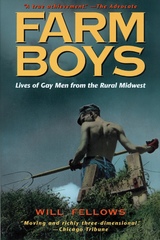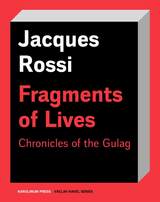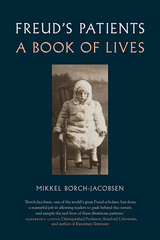117 books about Lives and 3
start with F
117 books about Lives and 3
117 books about Lives
3 start with F start with F
3 start with F start with F

Farm Boys
Lives of Gay Men from the Rural Midwest
Collected and Edited by William D. Fellows
University of Wisconsin Press, 1998
Homosexuality is often seen as a purely urban experience, far removed from rural and small-town life. Farm Boys undermines that cliche by telling the stories of more than three dozen gay men, ranging in age from 24 to 84, who grew up in farm families in the midwestern United States. Whether painful, funny, or matter-of-fact, these plain-spoken accounts will move and educate any reader, gay or not, from farm or city.
“When I was fifteen, the milkman who came to get our milk was beautiful. This is when I was really getting horny to do something with another guy. I waited every day for him to come. I couldn’t even talk to him, couldn’t think of anything to say. I just stood there, watching him, wondering if he knew why.”—Henry Bauer, Minnesota
“When I go back home, I feel a real connection with the land—a tremendous feeling, spiritual in a way. It makes me want to go out into a field and take my shoes off and put my feet right on the dirt, establish a real physical connection with that place. I get homesick a lot, but I don’t know if I could ever go back there and live. It’s not the kind of place that would welcome me if I lived openly, the way that I would like to live. I would be shunned.”—Martin Scherz, Nebraska
“If there is a checklist to see if your kid is queer, I must have hit every one of them—all sorts of big warning signs. I was always interested in a lot of the traditional queen things—clothes, cooking, academics, music, theater. A farm boy listening to show tunes? My parents must have seen it coming.”—Joe Shulka, Wisconsin
“My favorite show when I was growing up was ‘The Waltons’. The show’s values comforted me, and I identified with John-Boy, the sensitive son who wanted to be a writer. He belonged there on the mountain with his family, yet he sensed that he was different and that he was often misunderstood. Sometimes I still feel like a misfit, even with gay people.”—Connie Sanders, Illinois
“Agriculture is my life. I like working with farm people, although they don’t really understand me. When I retire I want the word to get out [that I’m gay] to the people I’ve worked with—the dairy producers, the veterinarians, the feed salesmen, the guys at the co-ops. They’re going to be shocked, but their eyes are going to be opened.”—James Heckman, Indiana
“When I was fifteen, the milkman who came to get our milk was beautiful. This is when I was really getting horny to do something with another guy. I waited every day for him to come. I couldn’t even talk to him, couldn’t think of anything to say. I just stood there, watching him, wondering if he knew why.”—Henry Bauer, Minnesota
“When I go back home, I feel a real connection with the land—a tremendous feeling, spiritual in a way. It makes me want to go out into a field and take my shoes off and put my feet right on the dirt, establish a real physical connection with that place. I get homesick a lot, but I don’t know if I could ever go back there and live. It’s not the kind of place that would welcome me if I lived openly, the way that I would like to live. I would be shunned.”—Martin Scherz, Nebraska
“If there is a checklist to see if your kid is queer, I must have hit every one of them—all sorts of big warning signs. I was always interested in a lot of the traditional queen things—clothes, cooking, academics, music, theater. A farm boy listening to show tunes? My parents must have seen it coming.”—Joe Shulka, Wisconsin
“My favorite show when I was growing up was ‘The Waltons’. The show’s values comforted me, and I identified with John-Boy, the sensitive son who wanted to be a writer. He belonged there on the mountain with his family, yet he sensed that he was different and that he was often misunderstood. Sometimes I still feel like a misfit, even with gay people.”—Connie Sanders, Illinois
“Agriculture is my life. I like working with farm people, although they don’t really understand me. When I retire I want the word to get out [that I’m gay] to the people I’ve worked with—the dairy producers, the veterinarians, the feed salesmen, the guys at the co-ops. They’re going to be shocked, but their eyes are going to be opened.”—James Heckman, Indiana
[more]

Fragments of Lives
Chronicles of the Gulag
Jacques Rossi
Karolinum Press, 2018
In Fragments of Lives, Gulag survivor Jacques Rossi opens a window onto everyday life inside the notorious Soviet prison camp through a series of portraits of inmates and camp personnel across all walks of life—from workers to peasants, soldiers, civil servants, and party apparatchiks. Featuring Rossi’s original illustrations and written in a tone as sharp and dry as that of Russian writer Varlam Shalamov, Rossi’s vignettes are also filled with surprising humor. A former agent in the Spanish Civil War and a lifelong Communist, Rossi never considered himself a victim. Instead, in the manner of Primo Levi, Solzhenitsyn, and Margaret Buber-Neumann, he sought to share and transmute his experience within the living hell of the Gulag. In so doing, he gives voice to the inmates whose lives were shattered by one of the most corrupt and repressive regimes of the twentieth century.
An impassioned reminder to always question one’s beliefs, to have the courage to give up one’s illusions at the risk of one’s life, Fragments of Lives lays bare, with acute observations and biting wit, the falsity of the Soviet utopia that transformed Rossi’s home into a “huge Potemkin village, a farcical sham dissimulating oceans of mud and blood.”
An impassioned reminder to always question one’s beliefs, to have the courage to give up one’s illusions at the risk of one’s life, Fragments of Lives lays bare, with acute observations and biting wit, the falsity of the Soviet utopia that transformed Rossi’s home into a “huge Potemkin village, a farcical sham dissimulating oceans of mud and blood.”
[more]

Freud's Patients
A Book of Lives
Mikkel Borch-Jacobsen
Reaktion Books, 2021
Portraits of the thirty-eight known patients Sigmund Freud treated clinically—some well-known, many obscure—reveal a darker, more complex picture of the famed psychoanalyst.
Everyone knows the characters described by Freud in his case histories: “Dora,” the “Rat Man,” the “Wolf Man.” But what do we know of the people, the lives behind these famous pseudonyms: Ida Bauer, Ernst Lanzer, Sergius Pankejeff? Do we know the circumstances that led them to Freud’s consulting room, or how they fared—how they really fared—following their treatments? And what of those patients about whom Freud wrote nothing, or very little: Pauline Silberstein, who threw herself from the fourth floor of her analyst’s building; Elfriede Hirschfeld, Freud’s “grand-patient” and “chief tormentor;” the fashionable architect Karl Mayreder; the psychotic millionaire Carl Liebmann; and so many others? In an absorbing sequence of portraits, Mikkel Borch-Jacobsen offers the stories of these men and women—some comic, many tragic, all of them deeply moving. In total, thirty-eight lives tell us as much about Freud’s clinical practice as his celebrated case studies, revealing a darker and more complex Freud than is usually portrayed: the doctor as his patients, their friends, and their families saw him.
Everyone knows the characters described by Freud in his case histories: “Dora,” the “Rat Man,” the “Wolf Man.” But what do we know of the people, the lives behind these famous pseudonyms: Ida Bauer, Ernst Lanzer, Sergius Pankejeff? Do we know the circumstances that led them to Freud’s consulting room, or how they fared—how they really fared—following their treatments? And what of those patients about whom Freud wrote nothing, or very little: Pauline Silberstein, who threw herself from the fourth floor of her analyst’s building; Elfriede Hirschfeld, Freud’s “grand-patient” and “chief tormentor;” the fashionable architect Karl Mayreder; the psychotic millionaire Carl Liebmann; and so many others? In an absorbing sequence of portraits, Mikkel Borch-Jacobsen offers the stories of these men and women—some comic, many tragic, all of them deeply moving. In total, thirty-eight lives tell us as much about Freud’s clinical practice as his celebrated case studies, revealing a darker and more complex Freud than is usually portrayed: the doctor as his patients, their friends, and their families saw him.
[more]
READERS
Browse our collection.
PUBLISHERS
See BiblioVault's publisher services.
STUDENT SERVICES
Files for college accessibility offices.
UChicago Accessibility Resources
home | accessibility | search | about | contact us
BiblioVault ® 2001 - 2024
The University of Chicago Press









